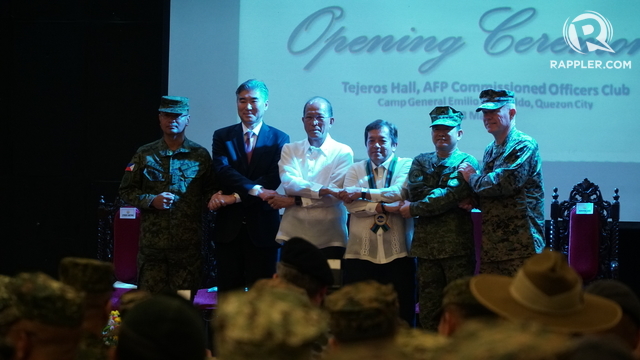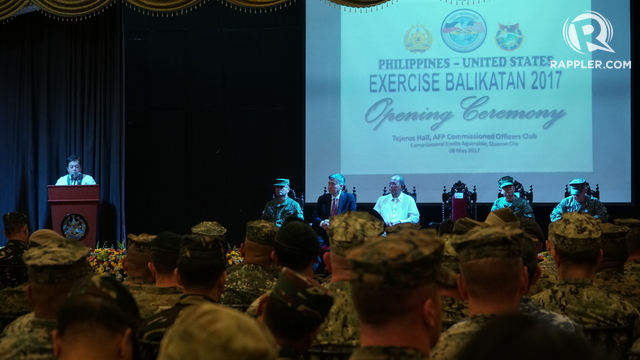(UPDATED) The annual activity adjusts to President Rodrigo Duterte's orders: Balikatan 2017 exercises will not focus on external defense or maritime security

JOINT DRILLS CONTINUE. Philippine and US officials link arms at the opening ceremony of Balikatan 2017. Photo by Jeff Digma/Rappler
(UPDATED) – After months of uncertainty, they made it.
Up to 2,600 American soldiers are in the Philippines to join the Balikatan 2017 exercises with 2,800 of their Filipino counterparts, an annual activity that President Rodrigo Duterte wanted scrapped last year as he threatened to cut ties with the United States.
A ceremony was held at 9 am on Monday, May 8, inside the Philippine military headquarters Camp Aguinaldo to formally start activities that will keep the ties between the two militaries strong.
The ceremony was attended by Philippine Defense Secretary Delfin Lorenzana, US Ambassador to the Philippines Sung Kim, Japanese Ambassador to the Philippines Kazuhide Ishikawa, Philippine Foreign Undersecretary Ariel Abadilla, and Armed Forces of the Philippines chief General Eduardo Año.
Kim said Balikatan is an "important military exercise" that has become a "meaningful embodiment of strong patnership" between the Philippines and the US.
Año underscored the long history of cooperation, fighting together during World War II, Korean War, Vietnam War, and the current global fight against terrorism.
"Balikatan literally means shoulder to shoulder... Our armed forces have continously shared ordeals that have strengthened our bond. It is an avenue for us to enhance cooperation between our military forces and an opportunity to test and validate our forces' inter-operability," Año said.
The annual Balikatan exercises are aimed at making sure the militaries can work jointly in the event the two countries need to activate the Mutual Defense Treaty, a 66-year-old treaty that binds them to come to each other's defense if one or the other's sovereignty is threatened.
Duterte, known for his anti-US rhetoric since he was mayor, had said he wants the Philippines to be independent of its former colonizer. A staunch critic of US presence in the Philippines, he is warming ties with China and Russia. (READ: Duterte's pivot to China won't be easy for Americanized PH military)
Adjusting to China

(UPDATED) – After months of uncertainty, they made it.
Up to 2,600 American soldiers are in the Philippines to join the Balikatan 2017 exercises with 2,800 of their Filipino counterparts, an annual activity that President Rodrigo Duterte wanted scrapped last year as he threatened to cut ties with the United States.
A ceremony was held at 9 am on Monday, May 8, inside the Philippine military headquarters Camp Aguinaldo to formally start activities that will keep the ties between the two militaries strong.
The ceremony was attended by Philippine Defense Secretary Delfin Lorenzana, US Ambassador to the Philippines Sung Kim, Japanese Ambassador to the Philippines Kazuhide Ishikawa, Philippine Foreign Undersecretary Ariel Abadilla, and Armed Forces of the Philippines chief General Eduardo Año.
Kim said Balikatan is an "important military exercise" that has become a "meaningful embodiment of strong patnership" between the Philippines and the US.
Año underscored the long history of cooperation, fighting together during World War II, Korean War, Vietnam War, and the current global fight against terrorism.
"Balikatan literally means shoulder to shoulder... Our armed forces have continously shared ordeals that have strengthened our bond. It is an avenue for us to enhance cooperation between our military forces and an opportunity to test and validate our forces' inter-operability," Año said.
The annual Balikatan exercises are aimed at making sure the militaries can work jointly in the event the two countries need to activate the Mutual Defense Treaty, a 66-year-old treaty that binds them to come to each other's defense if one or the other's sovereignty is threatened.
Duterte, known for his anti-US rhetoric since he was mayor, had said he wants the Philippines to be independent of its former colonizer. A staunch critic of US presence in the Philippines, he is warming ties with China and Russia. (READ: Duterte's pivot to China won't be easy for Americanized PH military)
Adjusting to China

IMPORTANT EXERCISE. US Ambassador to the Philippines Sung Kim underscores deep ties between the two countries. Photo by Jeff Digma/Rappler
Duterte was persuaded to allow the exercises to continue so far, but adjustments were made to follow his orders. There are no more exercises in the West Philippine Sea (South China Sea), for example.
Exercises in the West Philippine Sea were the highlight of Balikatan exercises in recent years, providing an opportunity to send China a message amid its aggressiveness in the disputed waters. (READ: The 'last' war games in the West Philippine Sea)
Regular activities in previous Balikatan exercises included amphibious landing drills coming from the West Philippine Sea and live fire drills that involved training Filipinos to operate long-range missiles.
The commander of the Western Command, the military unit responsible for the West Philippine Sea, was also previously tapped to be exercise director.
This time, no more. Instead of joint exercises on external defense and maritime security, Balikatan 2017 will focus on humanitarian assistance and disaster response, and combating terrorism.
Lieutenant General Oscar Lactao, the exercise director, said this is the direction that Duterte wants to take.

Duterte was persuaded to allow the exercises to continue so far, but adjustments were made to follow his orders. There are no more exercises in the West Philippine Sea (South China Sea), for example.
Exercises in the West Philippine Sea were the highlight of Balikatan exercises in recent years, providing an opportunity to send China a message amid its aggressiveness in the disputed waters. (READ: The 'last' war games in the West Philippine Sea)
Regular activities in previous Balikatan exercises included amphibious landing drills coming from the West Philippine Sea and live fire drills that involved training Filipinos to operate long-range missiles.
The commander of the Western Command, the military unit responsible for the West Philippine Sea, was also previously tapped to be exercise director.
This time, no more. Instead of joint exercises on external defense and maritime security, Balikatan 2017 will focus on humanitarian assistance and disaster response, and combating terrorism.
Lieutenant General Oscar Lactao, the exercise director, said this is the direction that Duterte wants to take.

AMERICAN MARINES. Lieutenant General Lawrence Nicholson of the US 3rd Marine Expeditionary Force is Balikatan exercise co-director. Photo by Jeff Digma/Rappler
Disaster preparedness
They will conduct mass casualty evacuation, urban search and rescue, underwater demolition, and fighting terrorism, among other activities to be held in the provinces of Samar, Cagayan, Isabela, Aurora, and Nueva Ecija.
Balikatan spokesman Major Celeste Sayson said the objective is to show that the Philippines is ready to address calamities, learning a lot from its experience with destructive Super Typhoon Yolanda (Haiyan) that killed around 6,000 people in 2013.
Exercises will also be held in Guiuan, Eastern Samar, where Yolanda made landfall. (READ: Soldiers of the world unite for Haiyan victims)
A few dozen participants from Australia and Japan will also participate in the exercises.
Among the assets that the Philippine military will use in the joint exercises is the brand new BRP Tarlac, currently the biggest ship in the navy's inventory. The strategic sealift vessel (SSV) can serve as a base of operations at sea.

STRONG TIES. Philippine Foreign Undersecretary Ariel Abadilla reads the speech of Philippine Foreign Secretary Enrique Manalo. Photo by Jeff Digma/Rappler
Disaster preparedness
They will conduct mass casualty evacuation, urban search and rescue, underwater demolition, and fighting terrorism, among other activities to be held in the provinces of Samar, Cagayan, Isabela, Aurora, and Nueva Ecija.
Balikatan spokesman Major Celeste Sayson said the objective is to show that the Philippines is ready to address calamities, learning a lot from its experience with destructive Super Typhoon Yolanda (Haiyan) that killed around 6,000 people in 2013.
Exercises will also be held in Guiuan, Eastern Samar, where Yolanda made landfall. (READ: Soldiers of the world unite for Haiyan victims)
A few dozen participants from Australia and Japan will also participate in the exercises.
Among the assets that the Philippine military will use in the joint exercises is the brand new BRP Tarlac, currently the biggest ship in the navy's inventory. The strategic sealift vessel (SSV) can serve as a base of operations at sea.

STRONG TIES. Philippine Foreign Undersecretary Ariel Abadilla reads the speech of Philippine Foreign Secretary Enrique Manalo. Photo by Jeff Digma/Rappler

No comments:
Post a Comment
Note: Only a member of this blog may post a comment.